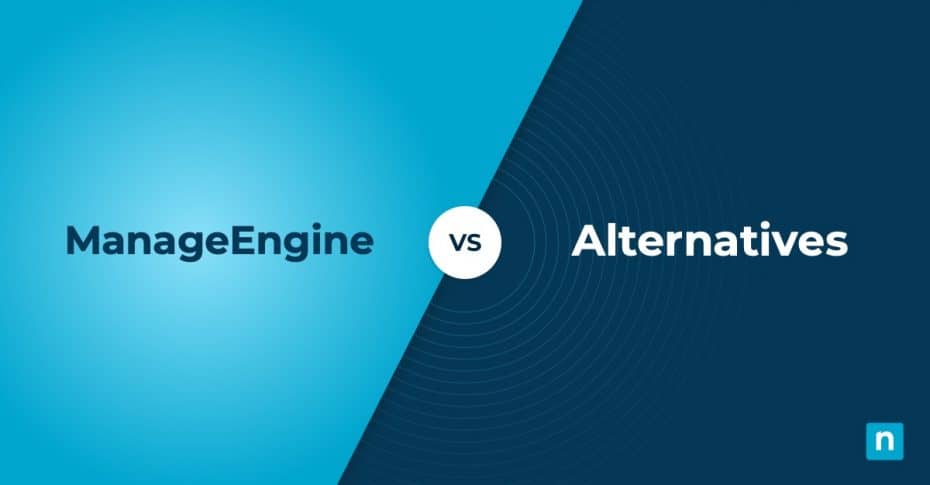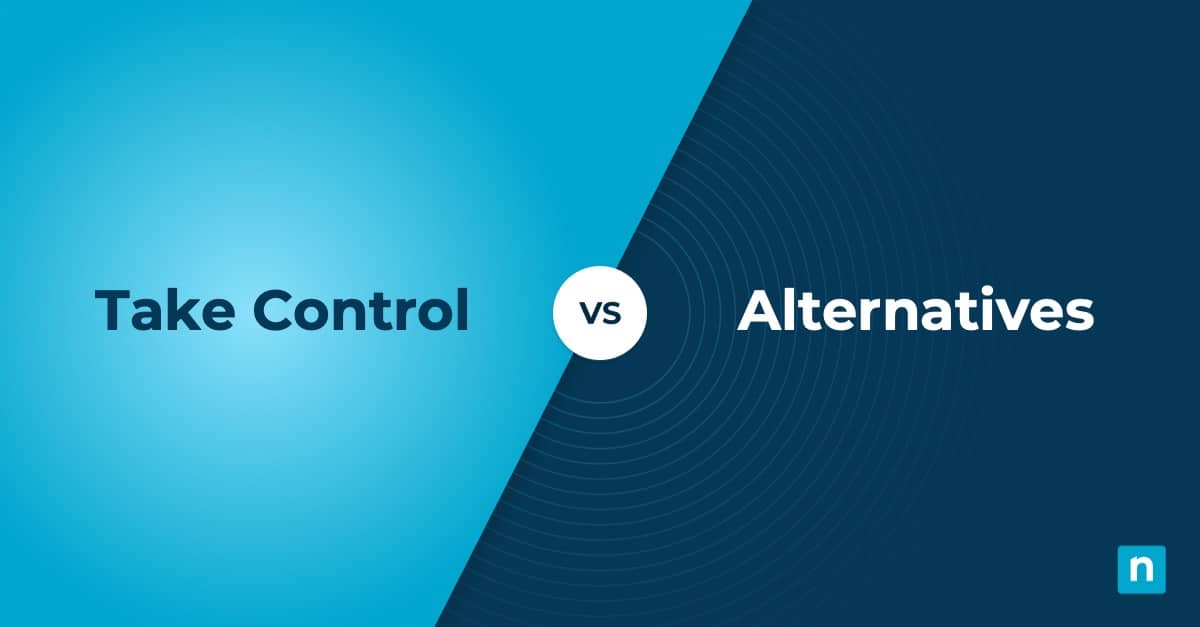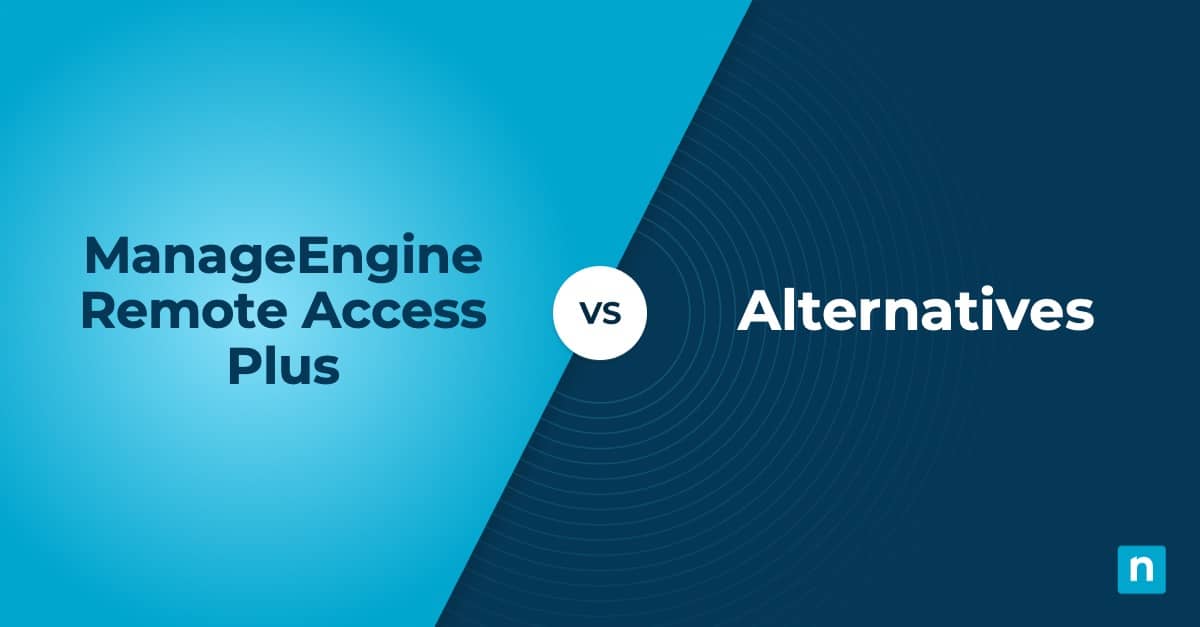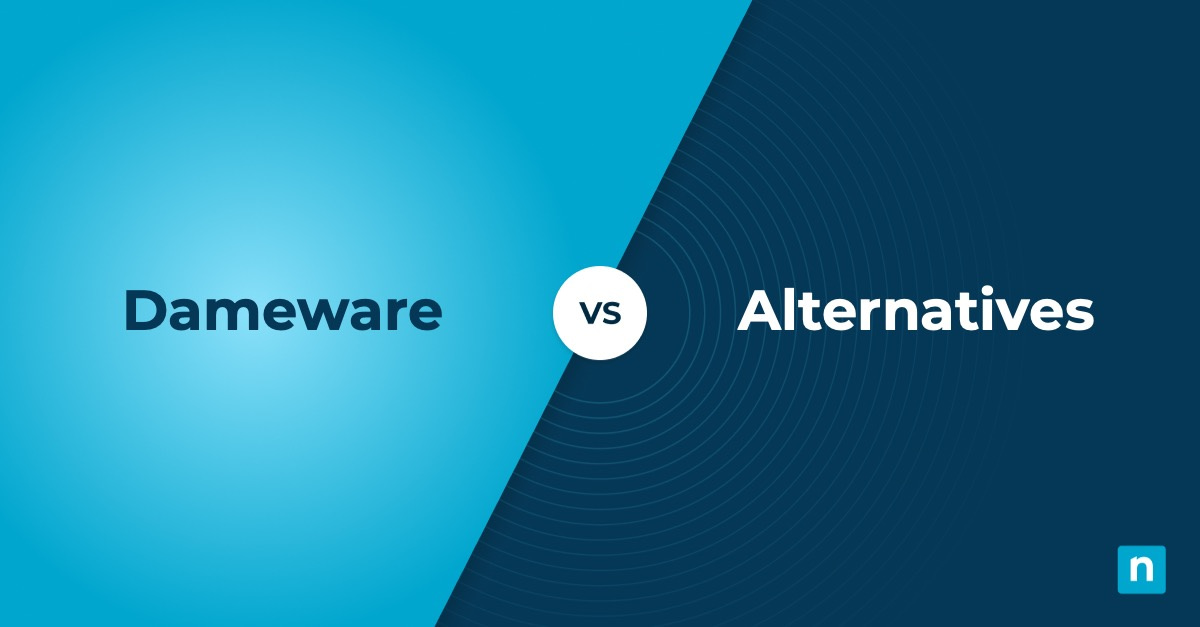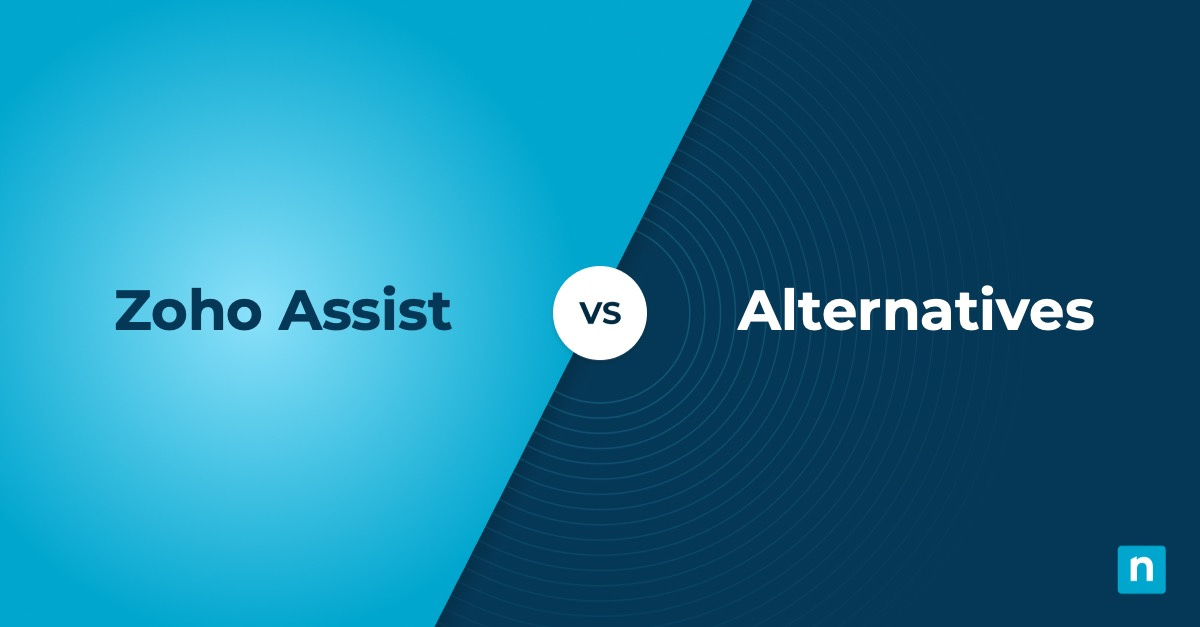Whether you’re a small business or a large enterprise, choosing the right endpoint management software is critical to your business success. The right remote monitoring and management tool can immediately optimize your business, reduce downtime, and give you the competitive advantage you need in your specific industry.
In your market research, you may have come across ManageEngine and wondered if its solution fits your needs. To recap, your endpoint management platform should have:
- Comprehensive IT management through a single pane of glass
- Behind-the-scenes and proactive support (Download the Proactive IT Management Guide)
- Streamlined and automated workflow
- Complete visibility
- Real-time remote monitoring and alerting
Ideally, your chosen vendor should be able to check all the boxes, including any customizations you need for your company. It’s okay if you haven’t figured out which solution you want just yet – that’s what this ManageEngine alternatives and competitors guide is for. This article will discuss the features you need to look for in your endpoint management software and some providers that can help you achieve your IT management goals.
1. NinjaOne
NinjaOne was created with one goal in mind: To help IT pros and MSPs efficiently manage, patch, and support all endpoints in the most cost-effective way possible. Since it began in 2013, it has helped over 15,000 customers in more than 80 countries automate their tasks, cut costs, and reduce risks. This dedication to excellence and innovation has contributed to the software being consistently rated as the #1 RMM on G2.
5 reasons to choose NinjaOne over ManageEngine
1. Easy integrations, even with legacy systems
One reason why some users look for ManageEngine alternatives is its lack of integration capability, especially for legacy systems. For larger MSPs with seasoned IT teams, this may be a little limiting, as you would need to manually configure a few features before you can use them. NinjaOne, on the other hand, offers a powerful system that is immediately usable across Windows, macOS, and Linux. Further, it can be easily integrated into almost any existing system so that you can start driving efficiency from day one.
2. Flexible and customizable reporting
While ManageEngine offers a sturdy RMM platform, it is not as flexible or customizable as NinjaOne. This is particularly important for larger IT pros that need to define different parameters for the organizations they manage. NinjaOne is known for its customization capabilities that allow you to meet every business goal, even as you scale.
3. Strong support
NinjaOne, rated #1 in customer support, believes in proactive endpoint management at every level. Compared to ManageEngine, Ninja responds quickly to IT requests. NinjaOne proudly offers one of the fastest response times in the IT industry today. This way, you are assured that your IT technicians always have the support they need whenever they need it.
4. Built for MSPs of all sizes
NinjaOne is a founder-owned and led organization that values innovation. As a result, it regularly updates its system to be as functional and user-friendly as possible, whether you’re managing 10 or 100,000 endpoints. NinjaOne listens to its customers’ feedback and continuously improves its solutions so it can better support them.
5. Lean RMM agents
An RMM agent is software you install on the devices you want to monitor. Ideally, these agents should consume as little resources as possible so that your monitored devices don’t eventually lag. One of the main issues users have with ManageEngine is that its solution consumes a large number of resources. NinjaOne designed its RMM to be as lean as possible.
Strengths of NinjaOne
- Reliable patch management. Arguably, one of the most important functions your endpoint management software must provide is dependable and consistent patch management. Patching helps you apply firmware and software updates to keep your IT network healthy and functional. Compared to other vendors, NinjaOne offers top-tier patch management that optimizes the performance of all your endpoints.
- Automated repetitive endpoint tasks. One of the main reasons why your IT team may be inefficient is a lack of automation. NinjaOne automates repetitive endpoint management tasks, such as device setup, so your technicians can focus on more complex, higher-level tasks.
- One-click device actions. NinjaOne’s RMM enables you to initiate actions, stop tasks, and even deploy remediations in one click. Further, the tool allows you to conduct all these tasks in the background, so you never interrupt your end users.
- Auto-remediation. NinjaOne allows you to create custom condition-based scripts so that you can fully automate any endpoint issue, such as stopped services, missed reboots, and missing applications. Not only does this reduce the need for manual intervention, but also lessens the risk of human error.
- Fast, intuitive UI. NinjaOne is fast – plain and simple. It was built specifically for IT teams across all industries, from government to financial, so you can optimize your IT processes. The goal is for you to feel confident and comfortable with the dashboard right away and not spend hours learning which tool does what task.
Customer story
Andrew Jones, an IT technician for the beautiful city of Vidalia, Louisiana, talks about how NinjaOne – especially its automated patch management tool – allowed him and his team to better meet the needs of his city.
“Compliance is very important for the agencies we manage, from CJIS compliance for our Police Department to PCI compliance for City Hall. Automating patch management through Ninja allows us to keep our operating systems up-to-date, making achieving compliance and reporting on compliance far easier,” says Andrew.
Aside from the easy-to-use patch management, Andrew says that he highly appreciates NinjaOne’s dedication to its customers, stating that he can always talk to someone over the phone whenever he has a concern.
You can read more NinjaOne customer stories or check out more NinjaOne reviews.
Pricing information
NinjaOne’s IT management software has no forced commitments and no hidden fees. You can request a free quote, schedule a 14-day free trial, or watch a demo.
Reviews
- 1,694 reviews (at the time of writing)
- 4.7 / 5 stars
- 236 reviews (at the time of writing)
- 4.8 / 5 stars
Do more with intuitive endpoint management software If you’ve been searching for an intuitive endpoint management solution that allows you to manage more endpoints per technician, NinjaOne may be the answer you’re looking for.
2. N-able N-central
N-able N-central considers itself a complete IT management tool and unified RMM for MSPs of all sizes. The company claims to be specifically designed for IT groups that need to scale right away. According to its reviews on G2, N-able was built with security in mind and allows organizations to monitor almost any device across various operating systems.
Pros:
- Remote monitoring. N-able centralizes all devices under one dashboard so that you can easily monitor and manage them anywhere where there is an internet connection.
- Automation manager. N-able N-central allows you to automate repetitive tasks so your IT technicians can work more efficiently.
- Simple interface. Compared to other vendors, N-able’s RMM is relatively simple to use and customize.
Cons:
- Limited mobile management. N-able’s mobile management functionality is not its core focus, which may be limiting to some MSPs. Compared to NinjaOne, you may find that N-able may not provide you with the tools you need.
- Support. One of the main challenges N-able users have had with the company is that they sometimes take longer to respond to IT tickets.
- May lag for larger enterprises. N-able is a feature-rich platform that may be a little inflexible as it needs to scale. This may make the solution lag for larger enterprises that require more features and functions.
See how N-able compares with NinjaOne or learn more about N-able N-central vs. ManageEngine Endpoint Central.
3. Kaseya
Kaseya offers cloud-based remote monitoring and management SaaS software. It markets itself mostly to small to medium-sized businesses looking to simplify and optimize their internal processes. According to its website, its solution is built on seven core functions: endpoint management, security, audit and compliance, unified backup, business services, networking, IT operations, and MSP enablement.
Pros:
- Policy-based automation. Kaseya allows you to automate certain endpoint management tasks based on various policies.
- Patch management. Kaseya offers a patch management tool that regularly scans software providers at pre-determined schedules and updates them as needed.
- Remote monitoring. Kaseya’s solution is a 100% remote solution that may benefit remote and hybrid teams.
Cons:
- May become expensive in the long run. Some previous Kaseya users have said that Kaseya only offers a few out-of-the-box features from the get-go. You may incur additional expenses as you need to add more features and functions.
- Support for macOS devices. Kaseya is better suited for MSPs that manage mostly Windows devices. Its support for macOS devices is limited and may be challenging as your organization expands.
- Takes time to learn and master. Kaseya is a complex platform that requires additional training and continual support. While this may be fine for more seasoned IT experts, this may be a limitation for less experienced IT technicians.
See how Kaseya compares with NinjaOne or learn more about Kaseya vs. ManageEngine Endpoint Central.
4. Atera
Atera is an IT management platform that showcases essential endpoint management functionalities. The platform is marketed towards enterprise IT departments and managed service providers (MSPs) looking for an endpoint management solution that is developed to streamline and scale IT operations.
Pros:
- Helpdesk. Atera is integrated with helpdesk and ticketing tools, helping IT teams streamline their issue identification and resolution.
- Network discovery. The platform offers continuous network discovery, ensuring visibility over digital assets within the network.
- Cybersecurity. Atera also offers built-in security features like multi-factor authentication and comprehensive activity logging, aiding IT teams in enforcing heightened infrastructure protection.
Cons:
- Reporting. Some Atera users pointed out that the platform’s reporting features could be improved by making them more customizable.
- Limited features. Other users noted that the platform has limited features compared to other endpoint management solutions.
- Script library. Some users suggested that it would be more helpful if Atera could add more basic premade scripts to its library for faster automation.
See how Atera compares with NinjaOne or learn more about Atera vs. ManageEngine Endpoint Central.
5. Ivanti Endpoint Manager
Ivanti Endpoint Manager is an IT solution that offers fundamental endpoint management functionalities. The platform is intended for IT departments and MSPs that want to employ unified endpoint management, helping them maximize productivity and enhance the security of their managed infrastructure.
Pros:
- Visual dashboard. Ivanti Endpoint Manager showcases a visual-centric dashboard that facilitates detailed status reporting.
- Remote access. The platform’s remote control capabilities help IT teams perform troubleshoots on remote devices, reducing desk visits.
- Hybrid workforce ready. Ivanti Endpoint Manager also offers products like Ivanti Nuerons developed for hybrid work environments.
Cons:
- Manual agent updates. Some Ivanti Endpoint Manager users highlighted the platform’s manual agent updates for each upgrade, which could potentially impact production environments.
- Complex setup. Others have mentioned that setting up Ivanti Endpoint Manager can sometimes be complex, affecting productivity.
- Occasional responsiveness issues. Some users say the platform could suffer occasional slowdowns when accessed over a VPN.
See how Ivanti Endpoint Manager compares with NinjaOne or learn more about Ivanti Endpoint Manager vs. ManageEngine Endpoint Central.
6. Datto RMM
Datto RMM is an IT platform that features essential endpoint management tools ideal for IT infrastructure requiring extensive monitoring, management, and security. This endpoint management solution is marketed toward small and medium-sized businesses (SMBs) and MSPs looking for an IT solution that focuses on remote monitoring and management while leveraging other UEM tools.
Pros:
- Remote access. Datto RMM is enhanced by its remote access feature, which helps IT teams and MSPs fix device issues remotely.
- Patch management. The platform’s flexible patch management capabilities can help organizations protect their infrastructures from threats by reducing vulnerabilities.
- Centralized console. Datto RMM offers a dashboard that integrates infrastructure monitoring with PSA functionalities.
Cons:
- UI navigation. Some Datto RMM users said the platform’s user interface could be improved by making it more streamlined and optimized for smoother navigation.
- Documentation. Others pointed out that Datto RMM has many advanced features that may not have comprehensive documentation, leading to implementation challenges.
- Initial setup. Some Datto RMM users mentioned encountering complexities during the initial setup process.
See how Datto RMM compares with NinjaOne or learn more about Datto RMM vs. ManageEngine Endpoint Central.
7. GoTo Resolve
GoTo Resolve is a platform that focuses mainly on IT support and is integrated with essential endpoint management capabilities. It is marketed towards organizations’ IT teams looking for a solution that provides comprehensive management and monitoring capabilities for different endpoints and an intuitive IT support system that streamlines ticket creation, assignment, and resolution.
Pros:
- Alerting. GoTo Resolve has a customizable alert policy threshold feature that promises to deliver crucial notifications and reduce false positives.
- Background access. The platform also has the capability of allowing IT administrators to access devices remotely despite user unavailability.
- Simplified automation. GoTo Resolve features pre-written scripts for a simplified automation process, improving task reliability by minimizing human-inflicted errors.
Cons:
- Remote user access. Some GoTo Resolve users expressed challenges in establishing remote user access on remote endpoints.
- Resource-heavy. Others noted that the platform can be resource-heavy, impacting system performance and responsiveness.
- Support and service. Some GoTo Resolve users expressed a desire for the platform’s support and service to be improved in terms of resolution speed.
See how GoTo Resolve compares with NinjaOne or learn more about GoTo Resolve vs. ManageEngine Endpoint Central.
8. Pulseway
Pulseway is a cloud-based IT platform that focuses on remote monitoring and management designed for businesses and organizations of all sizes. Aside from remote monitoring and management tools, Pulseway also offers other fundamental endpoint management functionalities ideal for internal IT departments and MSPs seeking an IT platform with robust RMM and UEM capabilities.
Pros:
- Self-service IT portal. Pulseway enables IT administrators to build resolution troubleshooters within the platform for end-user utilization, reducing support queues.
- Reporting templates. The platform also offers extensive reporting templates for a streamlined reporting task.
- PSA. Professional Services Administration tools are integrated within the Pulseway platform, easing the complexities of ticketing and troubleshooting.
Cons:
- Mobile app. Some Pulseway users lamented the platform’s mobile app features and ease of use, suggesting that they could be improved for a better user experience.
- Learning curve. Other users mentioned that the platform can cause a steep learning curve, especially when implementing its RMM and PSA features.
- Support for macOS. Some users noted that Pulseway’s support for macOS could be improved to match the features it offers for Windows.
See how Pulseway compares with NinjaOne or learn more about Pulseway vs. ManageEngine Endpoint Central.
9. SyncroMSP
SyncroMSP is an IT solution that markets its remote monitoring and management functionalities and integrated endpoint management capabilities. As the name suggests, the platform is marketed towards managed service providers but can also be ideal for IT teams, offering a suite of tools to manage and secure IT environments.
Pros:
- Integrations. SyncroMSP integrates with essential IT tools for tasks such as ACH billing, cybersecurity, remote access, and more tasks.
- IT alerting. The platform also allows IT administrators to set up customizable alerts, triggering notifications for critical events.
- Unified dashboard. SyncroMSP features a centralized console for infrastructure management, allowing IT administrators to carry out operations within a single platform.
Cons:
- Setup for macOS devices. Some SyncroMSP users wished setting up the platform for macOS devices could be as smooth as setting up Windows devices.
- Navigation challenges. Other users pointed out that navigating the platform could be improved by making it more simplified and streamlined.
- Mobile app. Some users commented on Pulseway’s mobile app, saying that the platform could integrate more helpful features to improve the mobile experience.
See how SyncroMSP compares with NinjaOne or learn more about SyncroMSP vs. ManageEngine Endpoint Central.
10. Microsoft Intune
Microsoft Intune is a cloud-based service that helps organizations manage devices and applications while ensuring data security. Developed by Microsoft, Intune supports remote management and policy enforcement, enabling IT administrators to maintain control over corporate resources. Intune integrates with other Microsoft services to streamline IT operations across various environments.
Pros:
- Hybrid workforce protection. Microsoft Intune leverages zero-trust security strategies to protect hybrid workforces’ IT environments from crucial threats.
- Cross-platform endpoint management. The IT solution also features cross-platform endpoint management that helps IT administrators manage and secure devices across various operating systems.
- Endpoint analytics. Microsoft Intune provides insights on endpoints’ health and other metrics. It can also offer recommendations for improving device performance through data-driven analysis.
Cons:
- Frequent interface changes. Some Microsoft Intune users said that the platform has frequent interface changes and rebranding, impacting workflows and may require users to adapt to new systems.
- Error message ambiguity. Other users said that error messages may be too generic, saying they could be improved by making them more detailed to to provide more specific information about the issue.
- Change propagation challenges. Some users said that Microsoft Intune could experience delays in propagating configuration changes to user devices, potentially impacting the end-user experience.
See how Microsoft Intune compares with NinjaOne or learn more about Microsoft Intune vs. ManageEngine Endpoint Central.
Evaluate ManageEngine alternatives to find the right fit for your MSP
Selecting the right RMM for your MSP does not have to be complicated. The best way to evaluate a solution is to first define your use cases and business requirements. A costly mistake is to assume that all RMMs offer the same features and benefits.
It’s worth noting that just as your business is unique, so should your remote monitoring and management solution. Consider all options available in the market today, and try the software solutions that could be a good fit. This way, you’ll know the features you like and the functionalities you need to work more effectively.

